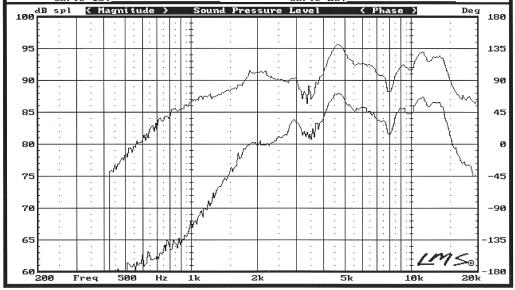PRELIMINARY
LISTENING
The
time has come for the ears to take over. Listening to the
speakers, the drivers sound fine crossed at 1,500Hz. My greatest
concern, the tweeter, did not exhibit the difficulty it was
going through earlier when it was crossed at 1,250Hz.
As
for the woofer, I am encouraged that all the hashes at the
upper end are well suppressed. That "brittleness"
that's associated to cone breakup is totally absent. Sonically,
the crossover point is seamless. Overlapping of drivers is
inaudible, resulting in a distinct Midrange transparency.
With
the cross point established, the next step is to refine the
sound. Even with 4th Order Linkwitz Riley networks, the music
is still very "Raw". Much more work needs to be
done to bring out the best from these Vifas.
Voicing
a Speaker
This is where it makes or breaks the speakers. Over a period
of a few weeks, the irregularities of the system were largely
ironed out. It was accomplished mainly by ear, using LMS only
to verify the outcome. The most difficult component was the
PL27 tweeter. About 90% of the work done was in fact on the
PL27. Let's have a look at what was involved.
|
|
RESONANT NOTCH FILTER
In
Figure 31, the top graph is the response of the PL27 without
any network.
The
lower graph is with the crossover, L-Pad and a Notch Filter
centered at 700Hz to null the Free Air Resonance Impedance
Peak of the PL27.
Note
that apart from the reduced SPL, the response is largely unchanged
from 20kHz to 3kHz. But from 3kHz to 1.8kHz, a large chunk
is missing.
This
was eventually traced to the Notch Filter. Apparently, the
Notch Filter, being so close to the crossover point has an
adverse effect on that region. |
 (Figure
31) 4th Order Linkwitz Riley High Pass
(Figure
31) 4th Order Linkwitz Riley High Pass |
FINAL
HIGH PASS
Removing
the Anti-Resonant Notch Filter restored the natural response
as can be seen in the solid curve in Figure 32.
However,
the tweeter is far from finished. The peaks and valleys span
almost a 10dB window. On playback, sibilance and shrillness
in violins were clearly discernible.
A
Notch Filter (L3, C3, R1) eventually tamed the peak at about
4kHz (Figure 33).
A
tweeter conjugate filter for impedance compensation that was
installed earlier, had to be removed and in its' place is
a shelving filter (R2, L4) instead. This prevented the higher
frequencies from climbing and allowed the shelving filter
to level off the frequencies above 10kHz.
In
the final crossover, the irregularities have been reduced
to about a 5dB window. This is a massive improvement from
its' initial 10dB.
This
may not seem much on paper but on listening, the improvements
are remarkable. Personally, I would have preferred to have
the frequency response flat to within + / - 1dB but with this
tweeter, this is about the practical limit.
|

(Figure
32) Final Frequency Response of PL27TG35

(Figure
33) Final High Pass Crossover Network for PL27TG35
|
FINAL LOW PASS
The
PL18 woofer fortunately, is less problematic compared to the
PL27 tweeter. With the crossover point well away from the
upper end, whatever nonsense from 3kHz upwards is well suppressed
(Figure 34).
However,
it presented an entirely different set of problems. Unlike
the tweeter, where LMS can be used to verify the equalization
circuits, the PL18 had to be tuned strictly by ear alone.
I did not have the luxury of LMS assisting me with measurements.
For
LMS to measure down to 100Hz, the Meter On Time will have
to be 10mSec. The space constraints of my lab will compromise
a Gated Measurement with a 10mSec window. The only practical
solution is to do a Ground Plane measurement. This of course
will have to be done out of the lab, which is impractical
when one is in the process of voicing a speaker.
Fortunately,
over the years working with this woofer, I have acquired an
intimate feel of its behavior. Using my collection of CDs,
it was obvious that the frequencies between approximately
200Hz to 600Hz could do with some cut. Due to this emphasis,
vocals pitch sounded like it has shifted slightly lower. A
very broad notch filter consisting of R5, L5, C4 in Figure
35, restored the vocals pitch. Cleared up the "veil"
in the voices too.
In
contrast to the tweeter, the conjugate network (R6, C7) is
a necessity. On removing this network, I was greeted with
a pronounced peak right at the shoulder of the rolloff.
|

(Figure
34) Final Frequency Response of PL18WO09

(Figure 35) Final Low Pass Network of PL18WO09
|
|
| |
| |
|
|
|
|